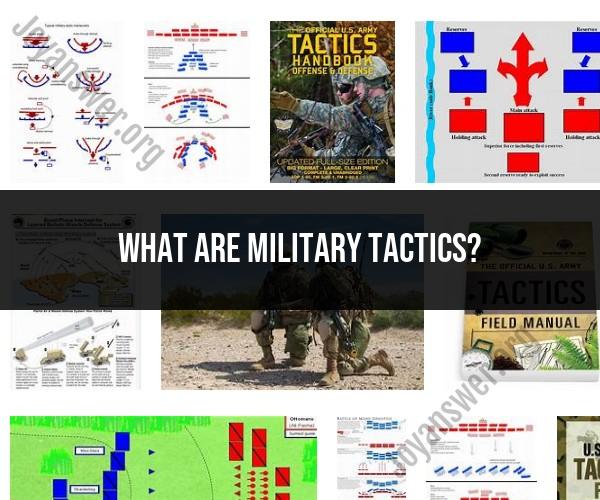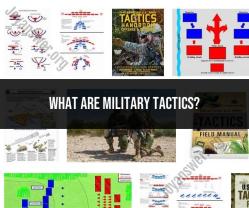What are military tactics?
Military tactics refer to the specific techniques, maneuvers, and procedures used by armed forces to achieve specific objectives on the battlefield. These tactics are the practical application of military strategy and involve the movement and deployment of troops, weaponry, and resources to gain advantages over the enemy. Military tactics can vary widely based on the nature of the conflict, the terrain, the technology available, and the goals of the military operation.
Here are some key components and concepts related to military tactics:
Fire and Maneuver: This is a fundamental infantry tactic where one element provides covering fire while another element advances or maneuvers to a new position. It's used to suppress the enemy while maintaining offensive pressure.
Ambush: Ambushing involves concealing troops or assets to surprise and attack the enemy when they pass by. Ambushes can be highly effective in disrupting enemy movements.
Flanking: Flanking is the act of attacking the enemy from the side or rear, where they are less defended. It's a classic maneuver to gain a positional advantage.
Pincer Movement: This is a two-pronged flanking attack where forces move simultaneously from both sides to encircle the enemy.
Guerrilla Warfare: Guerrilla tactics involve hit-and-run attacks, sabotage, and ambushes carried out by small, mobile, and often irregular forces. These tactics are employed to wear down a larger, conventional military.
Siege Tactics: Siege tactics are used to surround and isolate an enemy stronghold, cutting off their supplies and communications until they surrender or are forced to capitulate.
Defensive Tactics: Defensive tactics focus on fortifications, trenches, and other measures to protect a position. Counterattacks may also be used to repel enemy advances.
Infiltration: Infiltration tactics involve moving covertly behind enemy lines to gather intelligence, sabotage, or disrupt their operations.
Diversionary Tactics: These tactics involve creating diversions or secondary threats to distract the enemy from the primary objective.
Hit-and-Run: Hit-and-run tactics are often used by light, mobile units that attack the enemy quickly and then retreat to avoid retaliation.
Urban Warfare: Tactics for fighting in urban environments, such as cities, involve close-quarters combat, building clearing, and dealing with civilian populations.
Combined Arms: Modern warfare often involves the coordinated use of different branches of the military, including infantry, armor, artillery, and air support, to achieve a tactical advantage.
Asymmetric Warfare: This refers to situations where one side has a significant disadvantage in terms of resources, technology, or conventional forces. Asymmetric tactics often involve unconventional methods to compensate for these disadvantages.
Electronic Warfare: This includes tactics for disrupting or manipulating enemy communications, radar, and electronic systems.
Military tactics are continuously evolving as technology and warfare strategies change. The choice of tactics depends on various factors, including the specific mission, the capabilities of the military forces involved, and the nature of the adversary. Successful military commanders and leaders are adept at selecting and executing the right tactics to achieve their objectives while minimizing risks to their forces.
Military Tactics Demystified: A Comprehensive Guide
Military tactics are the plans and actions that military forces take to achieve their objectives in battle. Tactics are based on the principles of war, which are a set of fundamental truths about warfare that have remained largely unchanged throughout history.
The seven principles of war are:
- Objective: The objective is the desired outcome of a battle or campaign.
- Offensive: The offensive is the best form of defense.
- Mass: Concentrate your forces at the decisive point of battle.
- Economy of force: Use the minimum force necessary to achieve your objectives.
- Maneuver: Move your forces to positions of advantage.
- Unity of command: All forces must be under the command of a single commander.
- Security: Protect your forces from surprise attack.
Military tactics are used to implement the principles of war in battle. There are a variety of different military tactics, but some of the most common include:
- Ambush: An ambush is a surprise attack on an enemy force.
- Flank attack: A flank attack is an attack on the enemy's side or rear.
- Pincer movement: A pincer movement is an attack on the enemy from two sides.
- Feint: A feint is a false attack that is designed to deceive the enemy.
- Withdrawal: A withdrawal is a retreat from battle.
Military tactics are constantly evolving as new technologies and doctrines emerge. However, the principles of war remain the foundation of all military tactics.
Mastering the Art of Warfare: Understanding Military Tactics
Understanding military tactics is essential for military commanders and soldiers alike. Commanders need to be able to develop and execute tactical plans that will achieve their objectives in battle. Soldiers need to be able to understand and carry out their commanders' orders.
There are a number of factors that military commanders must consider when developing a tactical plan. These factors include:
- The enemy: The commander must consider the enemy's strength, weaknesses, and intentions.
- The terrain: The commander must consider the terrain on which the battle will be fought.
- The weather: The commander must consider the weather conditions that will be present during the battle.
- The time: The commander must consider the time of day and year at which the battle will be fought.
Military commanders must also be able to adapt their tactical plans as the situation on the battlefield changes. This requires flexibility and creativity.
Strategies and Maneuvers: Exploring the World of Military Tactics
Military tactics are used to implement military strategies in battle. A military strategy is a broad plan for achieving a military objective. Military tactics are the specific plans and actions that are taken to implement the strategy.
There are a number of different military strategies, but some of the most common include:
- Attrition: Attrition is a strategy of wearing down the enemy until they are forced to surrender.
- Annihilation: Annihilation is a strategy of destroying the enemy's forces completely.
- Maneuver: Maneuver is a strategy of moving forces to positions of advantage in order to force the enemy to surrender.
Military commanders use a variety of maneuvers to implement their strategies. Some of the most common maneuvers include:
- Encirclement: Encirclement is a maneuver to surround the enemy and cut off their supply lines.
- Penetration: Penetration is a maneuver to break through the enemy's lines and attack their rear.
- Retreat: A retreat is a maneuver to pull back forces in order to avoid destruction or to gain a better position.
Military tactics are a complex and ever-evolving subject. However, by understanding the principles of war and the most common tactics and maneuvers, you can gain a better understanding of the art of warfare.


